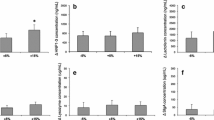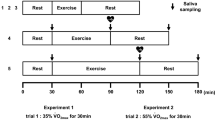Abstract
Purpose
Antimicrobial proteins (AMPs) in saliva including secretory immunoglobulin A (SIgA), lactoferrin (SLac) and lysozyme (SLys) are important in host defence against oral and respiratory infections. This study investigated the effects of hydration status on saliva AMP responses to endurance exercise.
Methods
Using a randomized design, 10 healthy male participants (age 23 ± 4 years, \(\dot{V}{\text{O}}_{{2{ \hbox{max} }}}\) 56.8 ± 6.5 ml/kg/min) completed 2 h cycling at 60 % \(\dot{V}{\text{O}}_{{2{ \hbox{max} }}}\) in states of euhydration (EH) or dehydration (DH) induced by 24 h fluid restriction. Unstimulated saliva samples were collected before, during, immediately post-exercise and each hour for 3 h recovery.
Results
Fluid restriction resulted in a 1.5 ± 0.5 % loss of body mass from baseline and a 4.3 ± 0.7 % loss immediately post-exercise. Pre-exercise urine osmolality was higher in DH than EH and overall, saliva flow rate was reduced in DH compared with EH (p < 0.05). Baseline SIgA secretion rates were not different between conditions; however, exercise induced a significant increase in SIgA concentration in DH (161 ± 134 to 309 ± 271 mg/L) which remained elevated throughout 3 h recovery. SLac secretion rates increased from pre- to post-exercise in both conditions which remained elevated in DH only. Overall, SLac concentrations were higher in DH than EH. Pre-exercise SLys concentrations were lower in DH compared with EH (1.6 ± 2.0 vs. 5.5 ± 6.7 mg/L). Post-exercise SLys concentrations remained elevated in DH but returned to pre-exercise levels by 1 h post-exercise in EH.
Conclusions
Exercise in DH caused a reduction in saliva flow rate yet induced greater secretion rates of SLac and higher concentrations of SIgA and SLys. Thus, DH does not impair saliva AMP responses to endurance exercise.




Similar content being viewed by others
Abbreviations
- ACTH:
-
Adrenocorticotrophic hormone
- AMPs:
-
Antimicrobial proteins
- ANOVA:
-
Analysis of variance
- BM:
-
Body mass
- DH:
-
Dehydration
- EH:
-
Euhydration
- FR:
-
Salivary flow rate
- HPA axis:
-
Hypothalamic-pituitary-adrenal axis
- HR:
-
Heart rate
- RPE:
-
Perceived exertion
- SLac:
-
Salivary lactoferrin
- SIgA:
-
Salivary secretory IgA
- SLys:
-
Salivary lysozyme
References
Adams WM, Ferraro EM, Huggins RA, Casa DJ (2014) The influence of body mass loss on changes in heart rate during exercise in the heat: a systematic review. J Strength Cond Res. doi:10.1519/JSC.0000000000000501
Allgrove JE, Gomes E, Hough J, Gleeson M (2008) Effects of exercise intensity on salivary antimicrobial proteins and markers of stress in active men. J Sports Sci 26:653–661. doi:10.1080/02640410701716790
American College of Sports Medicine, Sawka MN, Burke LM, Eichner ER, Maughan RJ, Montain SJ, Stachenfeld NS (2007) American College of Sports Medicine position stand. Exercise and fluid replacement. Med Sci Sports Exerc 39:377–390. doi:10.1249/mss.0b013e31802ca597
American Dietetics Association, Dietitians of Canada (2009) Nutrition and athletic performance, joint position statement. Med Sci Sport Exer. doi:10.1249/MSS.0b013e318190eb86
Bishop NC, Walker GJ, Scanlon GA, Richards S, Rogers E (2006) Salivary IgA responses to prolonged intensive exercise following caffeine ingestion. Med Sci Sports Exerc 38:513–519. doi:10.1249/01.mss.0000187412.47477.ee
Blannin AK, Robson PJ, Walsh NP, Clark AM, Glennon L, Gleeson M (1998) The effect of exercising to exhaustion at different intensities on saliva immunoglobulin A, protein and electrolyte secretion. Int J Sports Med 19:547–552. doi:10.1055/s-2007-971958
Borg G (1998) Borg’s perceived exertion and pain scales. Human Kinetics, Leeds
Chicharro JL, Lucia A, Perez M, Vaquero AF, Urena R (1998) Saliva composition and exercise. Sports Med 26:17–27
Davison G, Allgrove J, Gleeson M (2009) Salivary antimicrobial peptides (LL-37 and alpha-defensins HNP1-3), antimicrobial and IgA responses to prolonged exercise. Eur J Appl Physiol 106:277–284. doi:10.1007/s00421-009-1020-y
Fahlman MM, Engels HJ (2005) Mucosal IgA and URTI in American college football players: a year longitudinal study. Med Sci Sports Exerc 37:374–380. doi:10.1249/01.MSS.0000155432.67020.88
Fortes MB, Diment BC, Di Felice U, Walsh NP (2012) Dehydration decreases saliva antimicrobial proteins important for mucosal immunity. Appl Physiol Nutr Metab 37:850–859. doi:10.1139/h2012-054
Francesconi RP, Sawka MN, Pandolf KB, Hubbard RW, Young AJ, Muza S (1985) Plasma hormonal responses at graded hypohydration levels during exercise-heat stress. J Appl Physiol 59:1855–1860
Garth AK, Burke LM (2013) What do athletes drink during competitive sporting activities? Sports Med 43:539–564. doi:10.1007/s40279-013-0028-y
Gill SK, Teixeira AM, Rama L, Rosado F, Hankey J, Scheer V, Robson-Ansley P, Costa RJ (2013) Salivary antimicrobial protein responses during multistage ultramarathon competition conducted in hot environmental conditions. Appl Physiol Nutr Metab 38:977–987. doi:10.1139/apnm-2013-0005
Gillum TL, Kuennen M, Gourley C, Schneider S, Dokladny K, Moseley P (2013) Salivary antimicrobial protein response to prolonged running. Biol Sport 30:3–8. doi:10.5604/20831862.1029814
Gleeson M (2000) Mucosal immunity and respiratory illness in elite athletes. Int J Sports Med 21:S33–S43. doi:10.1055/s-2000-1450
Gleeson M, Bishop NC (2013) URI in athletes: are mucosal immunity and cytokine responses key risk factors? Exerc Sport Sci Rev 41:148–153. doi:10.1097/JES.0b013e3182956ead
Gleeson M, Pyne DB (2000) Special feature for the Olympics: effects of exercise on the immune system: exercise effects on mucosal immunity. Immunol Cell Biol 78:536–544. doi:icb956
Gleeson M, Bishop N, Walsh NP (2013) Exercise immunology. Routledge, London
Gore CJ, Bourdon PC, Woolford SM, Pederson DG (1993) Involuntary dehydration during cricket. Int J Sports Med 14:387–395. doi:10.1055/s-2007-1021197
Hucklebridge F, Clow A, Evans P (1998) The relationship between salivary secretory immunoglobulin A and cortisol: neuroendocrine response to awakening and the diurnal cycle. Int J Psychophysiol 31:69–76. doi:10.1016/S0167-8760(98)00042-7
Institue of Medicine (2005) Water: dietary reference intakes for water, sodium, cholride, potassium and sulfate. National Academy Press, Washington
Kanaley JA, Weltman JY, Pieper KS, Weltman A, Hartman ML (2001) Cortisol and growth hormone responses to exercise at different times of day. J Clin Endocrinol Metab 86:2881–2889. doi:10.1210/jcem.86.6.7566
Koutedakis Y, Sabin E, Perera S (1996) Modulation of salivary lysosyme by training in elite male swimmers. J Sports Sci 14:90
Kurdak SS, Shirreffs SM, Maughan RJ, Ozgunen KT, Zeren C, Korkmaz S, Yazici Z, Ersoz G, Binnet MS, Dvorak J (2010) Hydration and sweating responses to hot-weather football competition. Scand J Med Sci Sports 20(Suppl 3):133–139. doi:10.1111/j.1600-0838.2010.01218.x
Li TL, Gleeson M (2005) The effects of carbohydrate supplementation during repeated bouts of prolonged exercise on saliva flow rate and immunoglobulin A. J Sports Sci 23:713–722. doi:10.1080/02640410400022151
Malm C (2004) Exercise immunology: the current state of man and mouse. Sports Med 34:555–566. doi:10.2165/00007256-200434090-00001
Maresh CM, Whittlesey MJ, Armstrong LE, Yamamoto LM, Judelson DA, Fish KE, Casa DJ, Kavouras SA, Castracane VD (2006) Effect of hydration state on testosterone and cortisol responses to training-intensity exercise in collegiate runners. Int J Sports Med 27:765–770. doi:10.1055/s-2005-872932
Maughan RJ, Shirreffs SM (2011) IOC Consensus Conference on Nutrition in Sport, 25–27 October 2010, International Olympic Committee, Lausanne, Switzerland. J Sports Sci 29:S3–S4. doi:10.1080/02640414.2011.619349
Maughan RJ, Shirreffs SM, Merson SJ, Horswill CA (2005) Fluid and electrolyte balance in elite male football (soccer) players training in a cool environment. J Sports Sci 23:73–79. doi:10.1080/02640410410001730115
Mitchell JB, Dugas JP, McFarlin BK, Nelson MJ (2002) Effect of exercise, heat stress, and hydration on immune cell number and function. Med Sci Sports Exerc 34:1941–1950. doi:10.1249/01.MSS.0000039070.40418.90
Neville V, Gleeson M, Folland JP (2008) Salivary IgA as a risk factor for upper respiratory infections in elite professional athletes. Med Sci Sports Exerc 40:1228–1236. doi:10.1249/MSS.0b013e31816be9c3
Oliver SJ, Laing SJ, Wilson S, Bilzon JL, Walters R, Walsh NP (2007) Salivary immunoglobulin A response at rest and after exercise following a 48 h period of fluid and/or energy restriction. Br J Nutr 97:1109–1116. doi:10.1017/S0007114507682919
Perera S, Uddin M, Hayes JA (1997) Salivary lysozyme: a noninvasive marker for the study of the effects of stress of natural immunity. Int J Behav Med 4:170–178. doi:10.1207/s15327558ijbm0402_5
Petrovsky N, McNair P, Harrison LC (1998) Diurnal rhythms of pro-inflammatory cytokines: regulation by plasma cortisol and therapeutic implications. Cytokine 10:307–312. doi:10.1006/cyto.1997.0289
Sawka MN, Coyle EF (1999) Influence of body water and blood volume on thermoregulation and exercise performance in the heat. Exerc Sport Sci Rev 27:167–218
Volpe SL, Poule KA, Bland EG (2009) Estimation of prepractice hydration status of National Collegiate Athletic Association Division I athletes. J Athl Train 44:624–629. doi:10.4085/1062-6050-44.6.624
Walsh NP, Montague JC, Callow N, Rowlands AV (2004) Saliva flow rate, total protein concentration and osmolality as potential markers of whole body hydration status during progressive acute dehydration in humans. Arch Oral Biol 49:149–154. doi:10.1016/j.archoralbio.2003.08.001
West NP, Pyne DB, Renshaw G, Cripps AW (2006a) Antimicrobial peptides and proteins, exercise and innate mucosal immunity. FEMS Immunol Med Microbiol 48:293–304. doi:10.1111/j.1574-695X.2006.00132.x
West NP, Pyne DB, Renshaw G, Cripps AW (2006b) Antimicrobial peptides and proteins, exercise and innate mucosal immunity. FEMS Immunol Med Microbiol 48:293–304. doi:10.1111/j.1574-695X.2006.00132.x
Acknowledgments
The authors would like to thank Matthew Prestridge and Lauren Struszczak for their assistance with data collection and all participants for their patience and compliance during the study.
Conflict of interest
The authors declare that there is no conflict of interests regarding the publication of this paper.
Ethical standards
Experiments carried out within this study comply with current UK laws.
Author information
Authors and Affiliations
Corresponding author
Additional information
Communicated by Martin Flueck.
Rights and permissions
About this article
Cite this article
Killer, S.C., Svendsen, I.S. & Gleeson, M. The influence of hydration status during prolonged endurance exercise on salivary antimicrobial proteins. Eur J Appl Physiol 115, 1887–1895 (2015). https://doi.org/10.1007/s00421-015-3173-1
Received:
Accepted:
Published:
Issue Date:
DOI: https://doi.org/10.1007/s00421-015-3173-1




